Our favorite music genres- from different perspectives
For decades “the charts” have been the arbiter of consumer tastes in music. That makes sense. What’s selling (in CD days) or what’s streaming (today) lubricates the engine of the music industry. The charts drive revenue allocation and help to sort out the winners when it comes to fan appeal. Some pundits cite the streaming charts and conclude that the entire country is listening to Rap/Hip-Hop. Look at the Spotify Top 50 for any week, and you’ll see a list dominated by R&B/Hip-Hop artists. Boomers might argue that the last great album was Fleetwood Mac’s eponymous release- in 1975. Surveys asking music fans about the genres that they listen to and like the most don’t always align with the charts. Read on and you’ll see that there are very good reasons for this. The key takeaway- use all the tools at your disposal when you profile music fans.
What the charts say
Nielsen Music publishes a year-end summary with a wealth of data, including the top music formats and genres https://www.billboard.com/p/nielsen-music-mrc-datas-us-year-end-2019-report-us . The chart below shows Nielsen’s Share of Total Volume, which calculates “album sales” based on a formula of physical and digital sales, and on-demand streams. The R&B/Hip-Hop category dominates the Nielsen charts, which are published by its sister company Billboard. Rock is way more important to physical and digital download sales, but because these formats are in decline, on-demand tends to influence the charts.
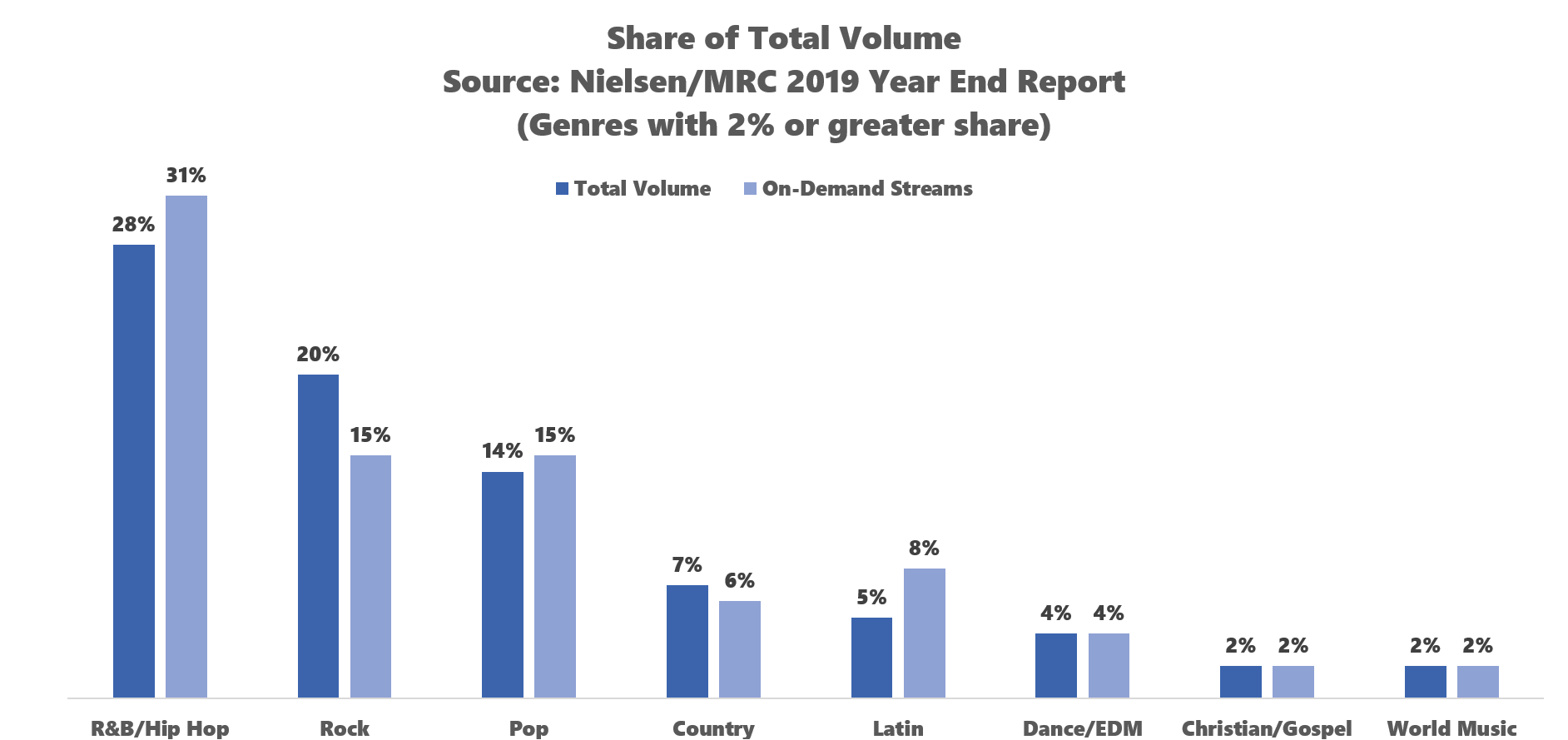
Survey says!
Each year MusicWatch asks consumers what music genres they regularly listen to, and which are their “favorites.” Favorites are genres that we listen to and purchase (the Nielsen categories) but also go to see live, track on social media, or buy merchandise. The MusicWatch categories are more detailed than what is shown in the Nielsen report, but Rock tops Rap as America’s “favorite” genre.
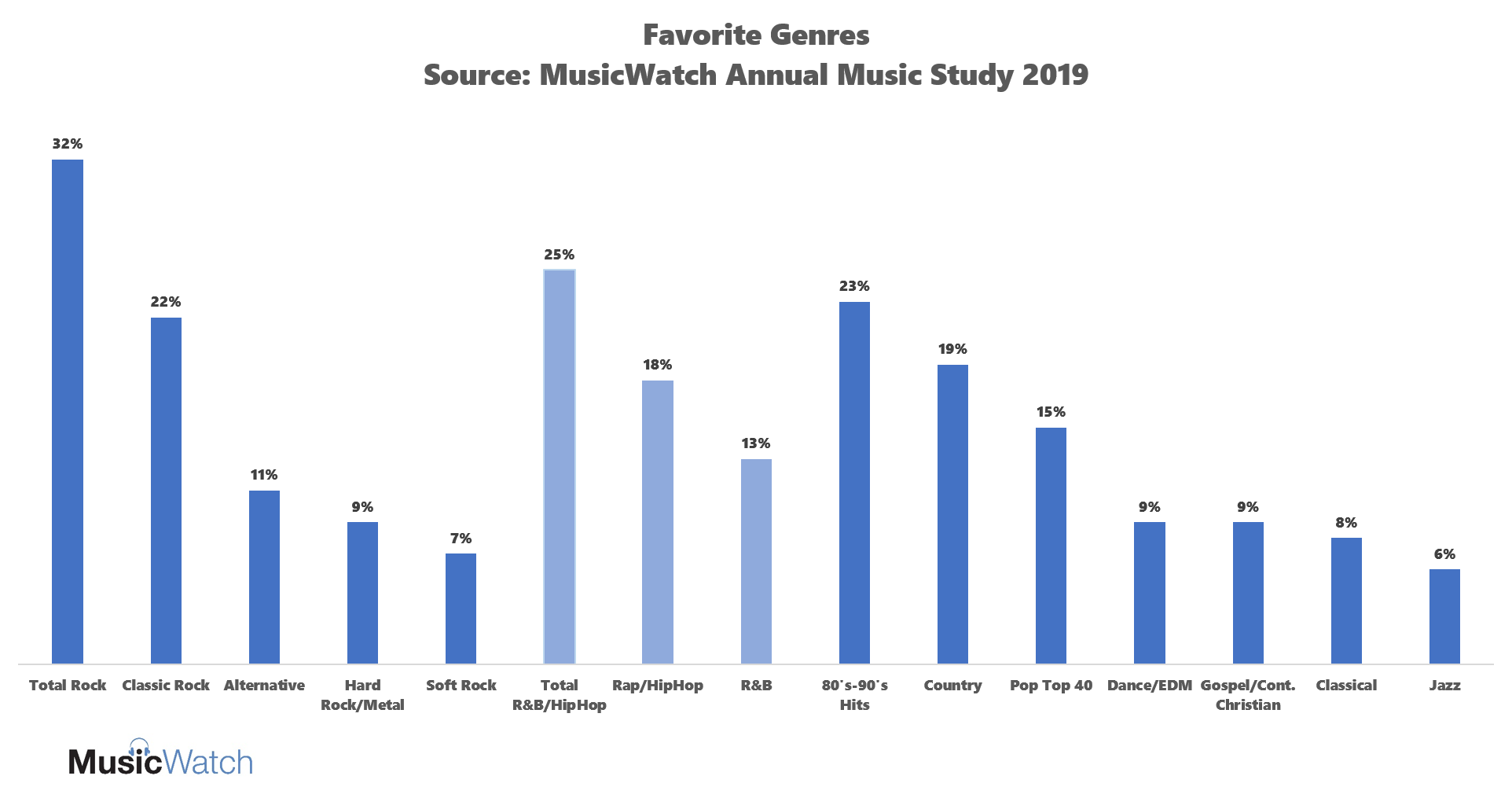
There are several factors that explain the difference between what tops the charts, and “favorites”.
The way we listen
On-demand streaming is becoming a powerhouse, with nearly 140 million listeners in the U.S. last year. As shown below, streaming accounts for 39% of our weekly listening and that includes interactive (e.g. not on-demand) services such as Pandora. But we also listen to music on broadcast radio, and on SiriusXM satellite radio. Nielsen points out that 6 of 10 of the top radio artists during the past decade were Country artists. Then there are our collections. We may not buy much anymore, but tens of millions of fans regularly listen to their CDs and iTunes downloads. The music genres that we consider our favorites are reflected in this diverse music consumption.
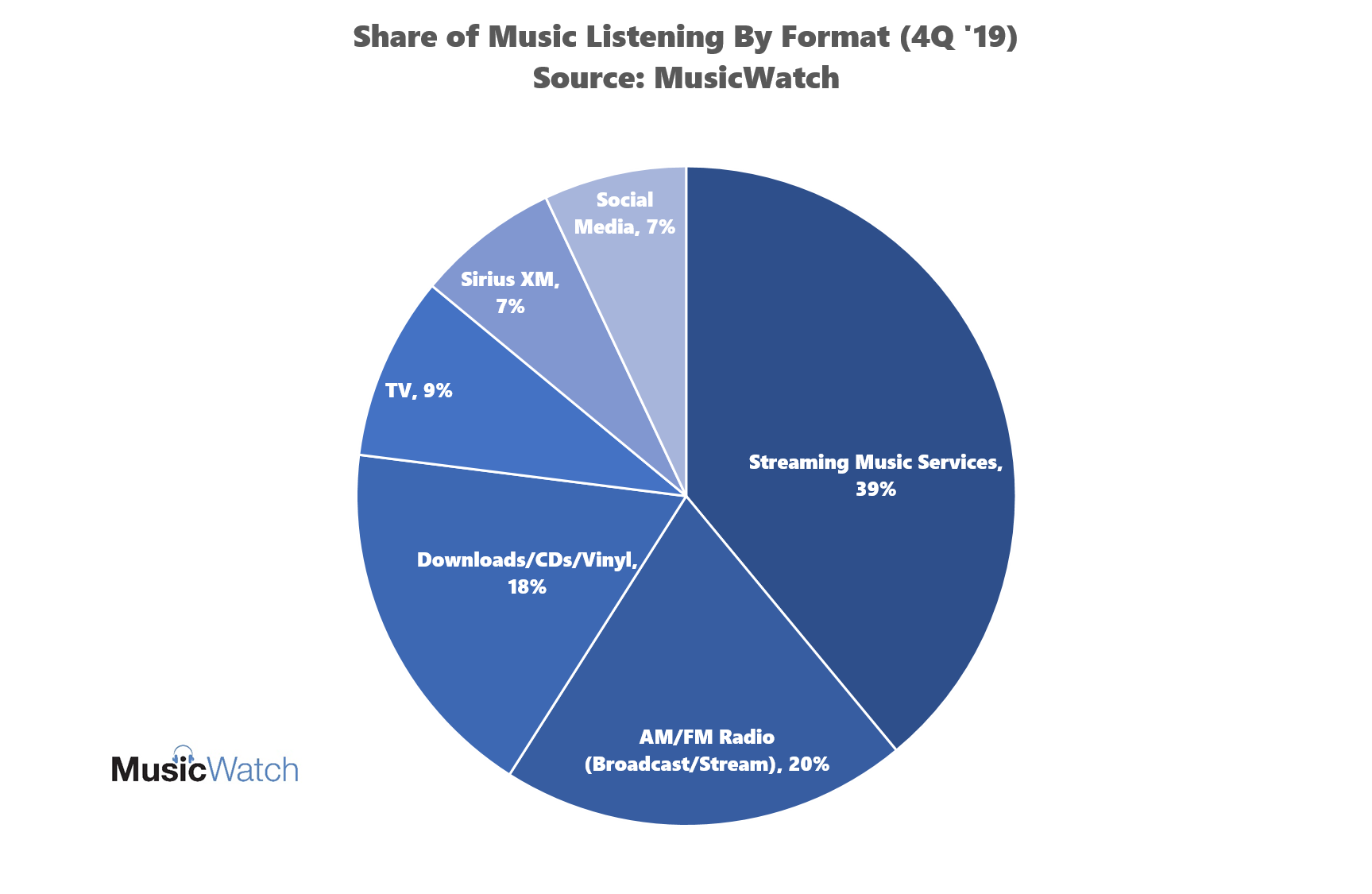
Charts are influenced by heavy listeners
Charts aren’t democratic; these days they are influenced by heavy listeners to on-demand streaming services. Not surprisingly, heavy listeners who spend 10 or more hours streaming each week are more likely to cite Rap/HipHop as their favorite genre. Light streamers prefer 80’s-90’s Hits and Classic Rock. The preferences of light streamers are very similar to those of heavy listeners of music on broadcast AM/FM radio, and heavy CD listeners. Radio is the most popular music format for in-car listeners. Age is a big factor in determining who is a heavy user of each of these formats.
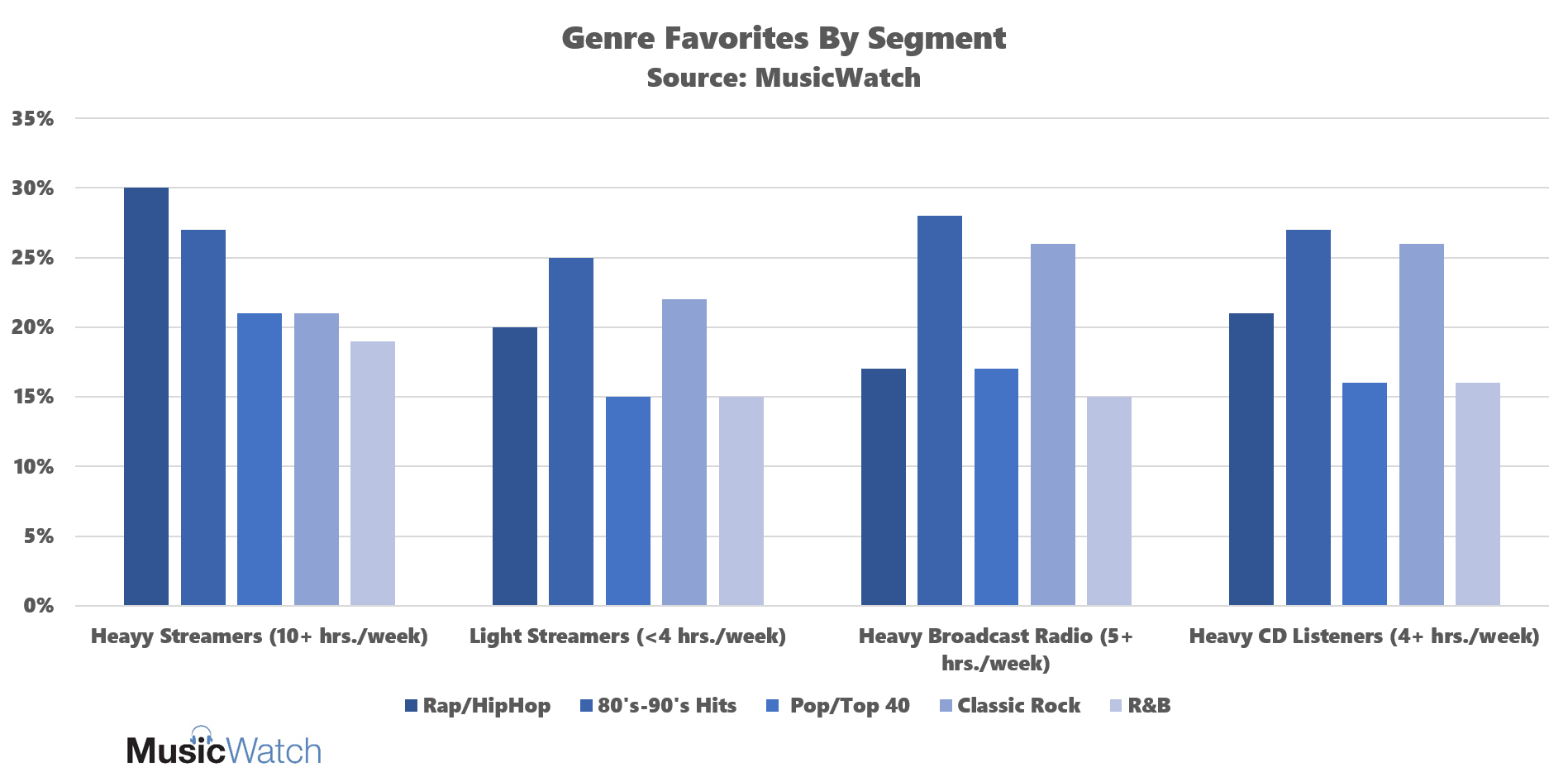 .
.
Soundtracks of our lives
Research has shown that our music tastes are mostly baked in by the time we reach age 30. So it’s not surprising that favorite genres vary depending on the era in which you grew up. The music industry often uses the phrase “Soundtracks of our lives” to describe this. Think of your first concert, the music posters in your room, a prom theme, or your wedding song. Even though we often cross genres when listening, these findings should not be a surprise:
- Gen Z claim R&B/HipHop as their favorite by a 2:1 margin over Rock (43% vs. 20%)
- Millennials associate with hits from the 80’s-90’s (28% favorite), then HipHop (25%) and Country (21%)
- Gen X prefer Rock and 80’s-90’s Hits by a 2:1 margin over R&B/HipHop
- Boomers favor Rock, mostly Classic Rock, and hits from the 50’s-70’s.
Popular culture treasures youth. But Gen X and Boomers account for half of the adult internet-using population. Their tastes matter. They are critical in driving revenue for live music, and account for a good portion of royalties that Sirius and Pandora contribute to artists.
The Convergence of Like, Live and Merch
You may have bought that CD of “Dark Side of the Moon” in 1985, but folks are still buying Pink Floyd t-shirts. The four favorite genres among music merchandise buyers are Classic Rock, 80’s-90’s Hits, Rap/HipHop and Country, in that order. atVenu, a live event commerce platform (back when we had live events), reports that t-shirts are the top selling event merch, with K-Pop, Pop and Hard Rock accounting for the highest per head sales- Rap/HipHop ranks #11 in average dollars per head (atVenu).
On the live side, heavy spenders on tickets to live events favor Classic Rock over Rap/HipHop by a 2:1 advantage. In 2019, the ticket side of the U.S. live music business drove nearly $8B in revenue, contrasted to $11B for recorded music*.
Considering that touring and merch account for a large portion of artist’s livelihoods it is vital to understand which genres are tops among big spenders.
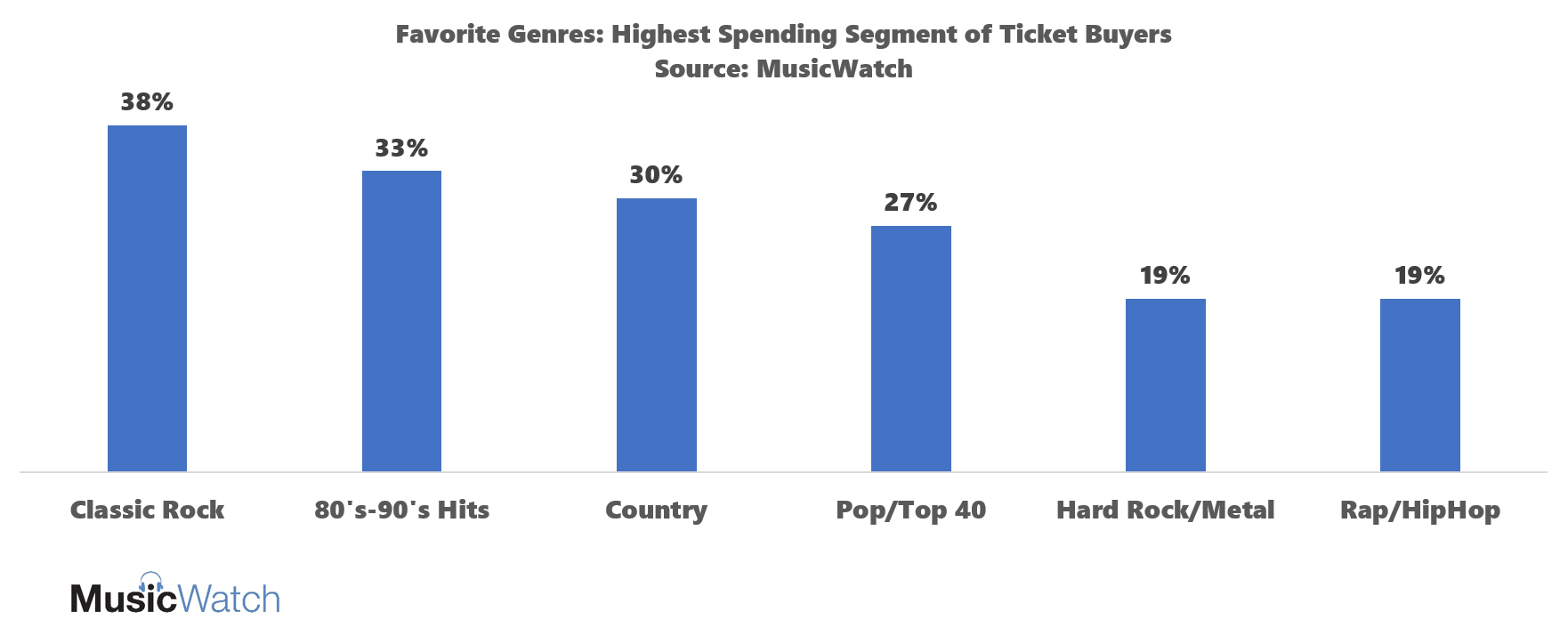
*Sources: Live tickets, Soundchart from PWC/Citi estimates; Recorded Music from RIAA- both 2019
New and emerging touchpoints for fans
There was a time when you expressed fanship by listening on the radio, buying CDs and going to shows. Today we have podcasts about music, podcasts featuring music, and TikTok. There is music in video games and music in gaming apps. Seven out of ten Americans use social media to relate to artists and live events; 29 percent regularly listen to music on social apps. Each of these outlets represent another touchpoint for fans to bond with “the soundtracks of their lives”.
Charts are the currency of the music business. It’s been nearly 30 years since the start of the “SoundScan era,” which used retail sales of CDs and cassettes to revolutionize how the charts were created. The charts have evolved to the new reality, where streaming accounts for 80% of US recorded music revenue (RIAA). Even as streaming comes to dominate how we listen, fans have a myriad of other options for connecting with their favorite music. To truly understand the DNA of music fans, we’ve got to think beyond the charts.